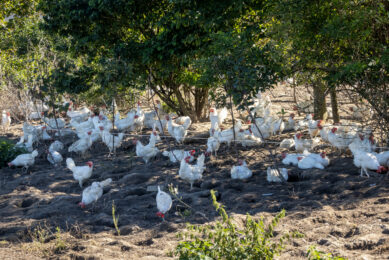The value of NIR: From particle size to final feed

More feed mills see the value of using NIR to get quick and accurate data from the incoming raw materials or complete feed. Alongside the increased usage, NIR also provides valuable insights on parameters such as ‘feed structure’ of feed pellets.
The use of near-infrared reflectance spectroscopy (NIR) helps feed mills to process many samples in an efficient and cost-effective way and determine the exact composition of feed ingredients within minutes. Trouw Nutrition offers NIR analyses of various parameters, including moisture, protein, fat, fibre, starch, and sugar in feed and raw materials. The company maintains one of the largest calibration databases in the industry, containing 15 million samples and counting. Every ten seconds on average, and every day of the year, one sample is analysed with the use of NIR and added to this database.
Better management of feed data
To easily manage, analyse and export the NIR data by its users (the nutritionists, formulators, procurement, and quality and assurance control), Trouw Nutrition revamped and retooled the MyNutriOpt portal in 2021. This cloud-based portal shows the nutritional values (based on the accurate and robust nutritional database of Trouw nutrition) of the samples that are scanned with desktop NIR devices at the feed mill or with mobile NIR. The users can then perform quality checks, see trends, make reports, or export the data to feed formulation software. Since the portal’s introduction, it has been increasingly implemented and used worldwide. Also, more features have been added and services integrated in the portal (such as LCA tools, animal models and mycotoxin services).
One of the main benefits of MyNutriOpt is that feed data management becomes easier and more transparent, which facilitates better decision making. In addition, everyone in the team looks and works at the same data. The whole feed mill team (including procurement, quality control and nutritionists) can access results, review the feed sample analyses, and consider outlier information. Shared data allows efficient collaboration between different team members. And this is also important when new team members join the company. Nutritional information and equations should not only be in people’s heads. The risk of losing that expertise is there when people leave the company or retire.
Learn more about how MyNutriOpt helps you manage animal nutrition in this video.
The different insights created by NIR
The uptake of NIR is growing, as more feed processionals see the benefits of having fast and accurate insights. Alongside the growth in overall use, we also see that the NIR is used for a wider range of insights. Around 40% of the NIR scans done by Trouw Nutrition customers are performed on finished feed samples. NIR can also be used to gain more detailed insights on valuable parameters such as particle size / feed structure.
NIR for finished feed
Checking finished feed is just as important as checking the incoming feed ingredients. Because when the final batch is not conforming to the formulation, it may lead to lagged animal performance in practice (and the risk for customer claims). Not checking the final feed, or using time-consuming or manual checks, can increase the risk that the feed has been sold and fed, but the complaints and costs (e.g., because of oversupplying protein) are detected much later. This can be prevented by having the right data at the right time. To make sure the final feed is according to the formulation it is therefore important that feed mills have quick and accurate NIR insights available on the finished feed samples so they can quickly compare the analyses values with the data standards.
NIR for feed structure
The structure of the feed can be defined as the size and internal binding strength (hardness) of feed particles. The fineness or coarseness of the particles is important for monogastric and important for development and health. For example, coarse structure stimulates gizzard development in broilers. This in turn can lead to improved nutrient digestibility, improved AME, and a fine particle distribution in the small intestine. A healthy gizzard is also able to better regulate the flow of feed. Overall, this leads to a better FCR, improved litter quality and better animal welfare. With NIR, we can measure the geometric mean diameter of the broiler pellet, the % of course particles (under 2000 µm and under 700 µm) and the % fine particles (under 300 µm). Having this type of data helps us to supply the right levels of structural components in the formulation.
NIR data for optimal diets and performance
We see an increased demand in the market for new digital tools that allow us to manage NIR data and create the insights needed for daily decision making. And having these insights available is increasingly important, due to quality issues, high feed prices and our quest to formulate precision diets. The use of wet chemistry methods for analysing raw materials is still applied widely in practice and can work well for some feed mills. In practice, NIR and wet chemistry are therefore both advised for feed analysis, depending on the customer’s needs. Yet, when more samples need to be processed due to changed raw material use, speed and quality checks for example, the move from wet chemistry to NIR can be the way forward.
If NIR is chosen to test feed ingredients and compound feed, MyNutriOpt is the way to get the insights, as this portal makes sure that all relevant NIR data comes together in one overview and accurate nutritional values are extracted from the data. And MyNutriOpt is constantly adding more features, parameters, and insights: from particle size to final feed, and more. Because feed formulation is an ever-changing profession, with increased pressure and new challenges. Having more NIR insights available helps to formulate the most optimal and cost-effective diets for optimal performance and business success.
If you want more information about MyNutriOpt and our formulation and nutrition expertise, please get in touch.






